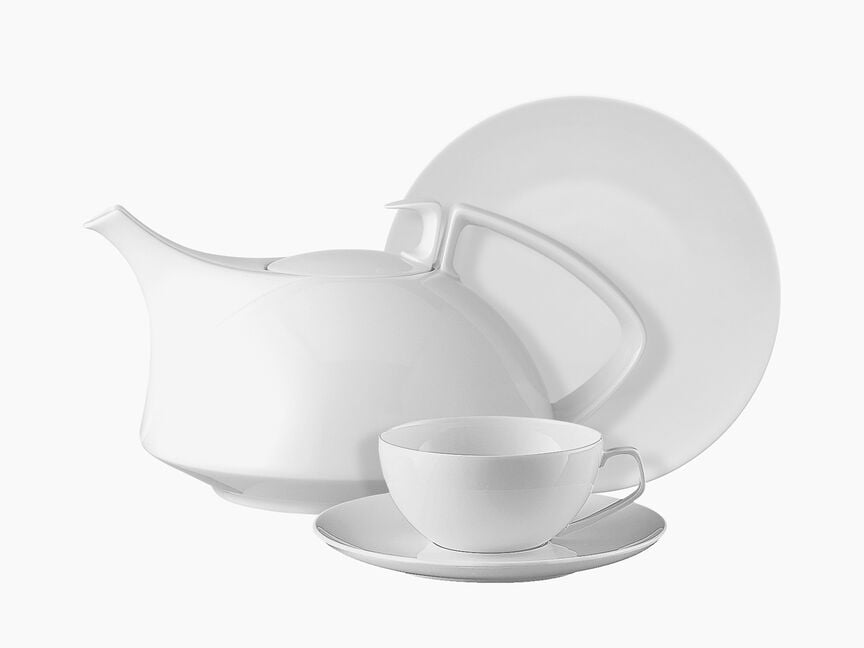Porcelain in the dishwasher: friend or foe?
When cleaning porcelain tableware, it depends on the decoration. White porcelain tableware without decoration is generally dishwasher-safe and easy to care for. However, even the Rosenthal tableware collections with elaborate decorations are usually dishwasher safe. Look for corresponding information such as “dishwasher safe” or “dishwasher suitable” in the product description. Rosenthal porcelain also has the best properties in terms of abrasion and scratch resistance.
 Gold rims and decorations in the dishwasher: special care for special details
Gold rims and decorations in the dishwasher: special care for special details
In Rosenthal tableware designs with decorations, the colors are melted into the glaze at over 1000°C. This softens the glaze and the decoration sinks into it. This makes the porcelain tableware indestructible in terms of color and luminosity. Decorations marked in this way have been tested by the Institute for Materials Technology (IWT) at Rosenthal GmbH. This makes care and cleaning of the porcelain tableware very easy.
The tableware can be safely cleaned in the dishwasher. Although Rosenthal porcelain tableware is highly resistant to abrasion and scratches, a little more care and special attention is required for gold and platinum decorations. Due to their natural material properties, gold and platinum coatings are not completely scratch-resistant. For elaborate gold decorations, therefore, use the gentle cycle at a maximum temperature of 55°C in the dishwasher or wash by hand using a mild detergent and soft sponges.
 Dishwasher-safe bone china – elegant, translucent, easy to care for
Dishwasher-safe bone china – elegant, translucent, easy to care for
Bone china is one of the finest types of porcelain in the world – light, delicate, yet particularly sturdy. The surface appears silky smooth and slightly translucent, but is technically a glass-like layer that should be treated accordingly. Rosenthal uses bone china in selected collections, such as the Rosenthal Brillance collection or the minimalist Jade tableware collection, which perfectly combine elegance and everyday practicality.
Despite its delicate nature, bone china is dishwasher safe, provided that a few points are observed: Over the years, deposits or discoloration can occur due to starch deposits from food, hard water, or incorrect detergent dosages – especially if dishwashers are not set optimally. These deposits can develop into a thin but stubborn film over time. To prevent this, we recommend the following measures:
- the correct dosage of detergent, dishwasher rinse aid, and salt,
- regular maintenance of the dishwasher,
- occasional cleaning of the porcelain with a liquid porcelain or ceramic hob cleaner.
Such stains do not affect the glaze – they can usually be removed completely. The harder and denser the material, the better it is protected against the effects of machine cleaning – a clear advantage of bone china and hard porcelain. Rosenthal uses only high-quality bone china, which not only looks impressive but also impresses in everyday use with its high dishwasher resistance.
Is porcelain heat-resistant and oven-proof?
Whether porcelain is oven-proof depends on how it is manufactured. High-quality porcelain, such as that produced by Rosenthal, is generally temperature-resistant and can be used in the oven. However, you should avoid sudden changes in temperature, as these can cause tension in the material.
Therefore, do not preheat the oven, but place the porcelain in the cold oven and heat it slowly. Avoid direct contact with open flames or hotplates. It is also possible to freeze porcelain, but it should be completely thawed before reheating to avoid overstressing the material.
 Microwave-safe tableware
Microwave-safe tableware
Rosenthal porcelain without metal trims can be safely used in the microwave – ideal for quickly reheating food. Series with gold or platinum rims are excluded from this. If in doubt, please refer to the information on the product detail page.

 Hand wash for high-quality decorations
Hand wash for high-quality decorations
With this decor, the appearance of the porcelain and its artistic design are paramount. Dishwasher safety is deliberately not a priority here. The use of high-quality colors and the subtle design mean that the dishwasher should not be used. This decor has been tested by the Institute for Materials Technology (IWT) at Rosenthal GmbH. The tableware should only be washed by hand.

 Gold rims and decorations in the dishwasher: special care for special details
Gold rims and decorations in the dishwasher: special care for special details Dishwasher-safe bone china – elegant, translucent, easy to care for
Dishwasher-safe bone china – elegant, translucent, easy to care for Microwave-safe tableware
Microwave-safe tableware
 Hand wash for high-quality decorations
Hand wash for high-quality decorations
 Cleaning dishwasher-safe glasses correctly
Cleaning dishwasher-safe glasses correctly

